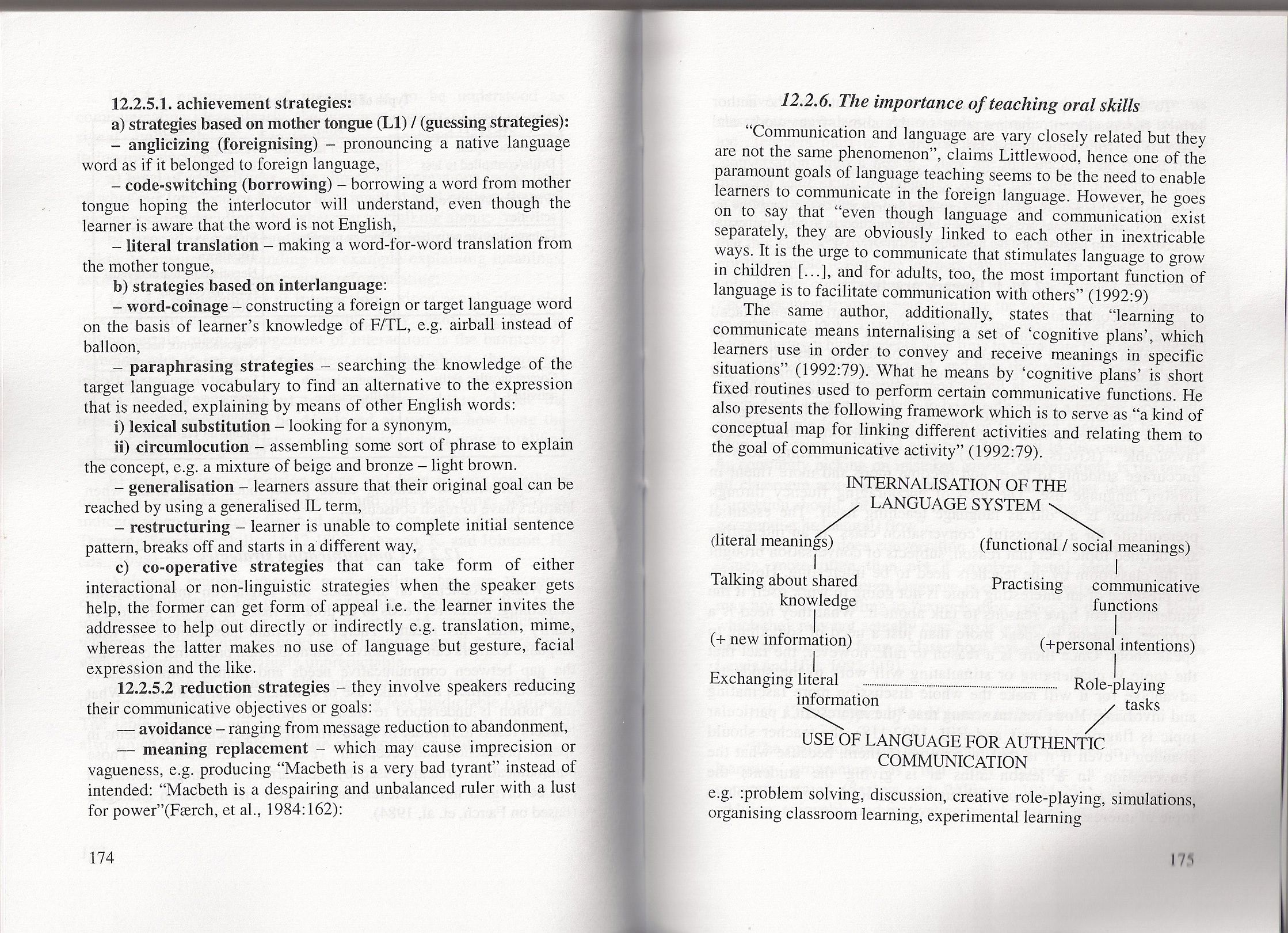63963 skanowanie0087 (2)

12.2.5.1. achievement strategies:
a) strategies based on mother tongue (LI) / (guessing strategies):
- anglicizing (foreignising) - pronouncing a native language word as if it belonged to foreign language,
code-switching (borrowing) - borrowing a word from mother tongue hoping the interlocutor will understand, even though the leamer is aware that the word is not English,
- literał translation - making a word-for-word translation from the mother tongue,
b) strategies based on interlanguage:
- word-coinage - constructing a foreign or target language word on the basis of leamer’s knowledge of F/TL, e.g. airball instead of balloon,
- paraphrasing strategies - searching the knowledge of the target language vocabulary to find an altemative to the expression that is needed, explaining by means of other English words:
i) lexical substitution - Iooking for a synonym,
ii) circumlocution - assembling some sort of phrase to explain the concept, e.g. a mixture of beige and bronze - light brown.
- generalisation - learners assure that their original goal can be reached by using a generalised IL term,
- restructuring - learner is unable to complete initial sentence pattem, breaks off and starts in a different way,
c) co-operative strategies that can take form of either interactional or non-linguistic strategies when the speaker gets help, the former can get form of appeal i.e. the leamer invites the addressee to help out directly or indirectly e.g. translation, mime, whereas the latter makes no use of language but gesture, facial expression and the like.
12.2.5.2 reduction strategies - they involve speakers reducing their communicative objectives or goals:
.r— avoidance - ranging from message reduction to abandonment,
- . ■— meaning replacement - which may cause imprecision or vagueness, e.g. producing “Macbeth is a very bad tyrant” instead of intended: “Macbeth is a despairing and unbalanced ruler with a lust for power”(Faerch, et al., 1984:162):
12.2.6. The importance ofteaching orał skills
“Communication and language are vary closely related but they are not the same phenomenon”, claims Littlewood, hence one of the paramount goals of language teaching seems to be the need to enable leamers to communicate in the foreign language. However, he goes on to say that “even though language and communication exist separately, they are obviously linked to each other in inextricable ways. It is the urge to communicate that stimulates language to grow in children [...], and for adults, too, the most important function of language is to facilitate communication with others” (1992:9)
The same author, additionally, States that “leaming to communicate means internalising a set of ‘cognitive plans’, which learners use in order to convey and receive meanings in specific situations” (1992:79). What he means by ‘cognitive plans’ is short fixed routines used to perform certain communicative functions. He also presents the following framework which is to serve as “a kind of conceptual map for linking different activities and relating them to the goal of communicative activity” (1992:79).
INTERNALISATION OF THE LANGUAGE SYSTEM \
(literał meanings)
Talking about shared knowledge
(functional / social meanings)
Practising communicative functions
(+ new information)
(+personal intentions)
Exchanging literał .....'rRole-playing
information / tasks
USE OF LANGUAGE FOR AUTHENTIC COMMUNICATION
e.g. :problem solving, discussion, creative role-playing, simulations, organising classroom leaming, experimental leaming
173
Wyszukiwarka
Podobne podstrony:
skanowanie0087 (2) 12.2.5.1. achievement strategies: a) strategies based on mother
skanowanie0094 (2) 12.3.3.1. Reading strategies Grauberg maintains that “reading strategies should h
26953 skanowanie0094 (2) 12.3.3.1. Reading strategies Grauberg maintains that “reading strategies sh
26953 skanowanie0094 (2) 12.3.3.1. Reading strategies Grauberg maintains that “reading strategies sh
Ryszard Broi, Andrzej Sztando, Strategie construction of local economy innovation based on the examp
skanowanie0062 (6) Keys to presentation (based on Harmer 1986, Harmer 1991): • for
CLILPYRAMID of Quality CUL based on the 4Cs-Framew,ork can only be achieved when all the four C: are
TRÓJWYMIAROWY EFEKT STRATEGICZNY -Skupia on: 1. wartości i korzyści osiągane przez nabywcę, 2. efekt
12 Harmonijna strategia finansowania aktywów obrotowych zakłada pełne pokrycie stałych aktywów
12. Analiza strategiczna SWOT składa się z następujących elementów II)
44 45 (12) 44 Strategia zagranicznej ekspansji przedsiębiorstw i niski stopień wykorzystania potencj
Monthly Temperaturę (T2m) Anomalies valid for week: from 06 to 12 July 2020 Map processed by EFFIS S
What can TPM do for YOU? TPM is based on the ideas of optimizing equipment effectiveness, achieving
кк) Wpływa negatywnie na pracowników 12. Analiza strategiczna SW
12. Analiza strategiczna SWOT składa się z następujących elementów II)
więcej podobnych podstron